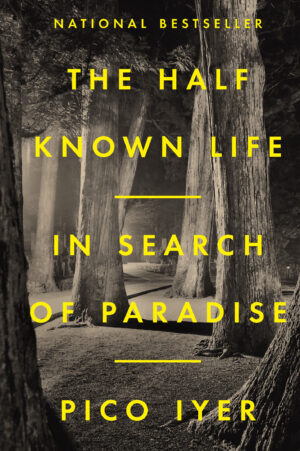The Half-Known Life: In Search of Paradise
by Pico Iyer
reviewed by Laura Albritton
Pico Iyer has made a name for himself by writing about his wide-ranging travels and his search for meaning in foreign lands in books like Video Night in Kathmandu and Falling Off the Map. In his latest volume, The Half Known Life: In Search of Paradise, Iyer embarks on a quest to comprehend, and even find, “paradise.” Iyer is seeking not so much an actual location as an appreciation for what disparate peoples understand by “paradise” or “utopia.” His search takes him to cities as far-flung as Belfast, Varanasi, Jerusalem, Mashhad, and Kandy—all “troubled places.” The perplexing connection between holy sites, faith, and conflict becomes a central preoccupation of the book.
In an interview, Iyer explains that the title, “the half-known life,” refers to “the sense that everything important in life—from love to death, from faith to wonder—lies beyond our grasp,” and that his job “is to try to write lucidly about what’s unfathomable.” Only a writer as accomplished and inquisitive as Iyer could set himself such a daunting task. And while his reflections on religion and conflict are often inconclusive, he conjures up a vivid sense of place and poses provocative questions.
Nowhere is the relationship between holiness and discord more evident than in “The Holy City,” a chapter about Jerusalem. Here, Iyer describes Islamic, Jewish, and Christian sites and believers; in one instance, he observes the tension between two rival camps—Ethiopians and Copts—who have laid claim to the Chapel of St. Michael and “come to [literal] blows over the tiny territory they shared.” Iyer notes that “the fighting was not just between traditions, but within them.” In Jerusalem past and present, the sacred is intertwined with violence; the city’s history is “a cautionary tale, a warning about what we do when we’re convinced we know it all.” Iyer’s judgment, that Jerusalem is a “place where everyday morality and religion part ways,” is damning, but not uncompassionate.
Even as Iyer is occasionally moved by the devotion expressed within Jerusalem’s candlelit shrines, The Half Known Life is free of religious as well as political partisanship. Iyer believes that Israelis and Palestinians “both have fair claim to the land beneath their feet.” A guide named Amir suggests the Israeli-Palestinian struggle is “not a problem …. It’s an issue. A problem you can solve. An issue you have to live with.”
Even with his profound observations, Iyer does not ultimately arrive at satisfactory conclusions about the mysteries of religion and sectarian violence. Despite this shortcoming, Iyer conjures up the locales with deft detail wherever he ventures. In Srinagar, Kashmir, the territory disputed by India and Pakistan and favored by the British Raj, he notes “a jumble of old Hindu temples, crumbling, two-story wooden houses, mosques with pagoda towers, next to tidy cottages that might have been set beside the Thames.” In Mashhad, at the Imam Reza Shrine, he witnesses pilgrims “releasing white doves into the blue-black sky” and “black-turbaned ayatollahs.” Yet these scenes of religious devotion are juxtaposed with disturbing realities. In Iran, he experiences a “surveillance culture,” pervaded by “ta’arof,” the custom of “never saying exactly what you mean.”
Iyer struggles to reconcile the inconsistencies and discord he observes in many “troubled places.” Over breakfast in Sri Lanka, he reads the news of a suicide bombing and a murder “three miles from where I was buttering my toast”: evidence of the ongoing Tamil-Sinhalese conflict. Iyer asks, “What is it about these paradise places … that throws off such a disquieting charge?”
At times, the book descends into bewilderment. In the desolate town of Broome, Australia, Iyer becomes rattled by the stormy weather, dangerous wildlife, and eerie atmosphere. While walking home one day, he is followed by Aboriginal locals and feels menaced: “It didn’t really matter which of us, if either, was in the wrong. This wasn’t my place, and it had been theirs for six hundred centuries or more.” Frightened, he runs to his motel and bolts the door.
If remote Australia is the nadir of Iyer’s quest, then the time he spends with the Dalai Lama in Japan represents its zenith. The author has known and admired the Tibetan spiritual leader for several years. According to Iyer, the Dalai Lama “had no interest in wishful or romantic notions,” and he “never really heard him speak about Paradise (or Nirvana); such ideas could only be a distraction from the possibilities of real life.” The Half-Known Life functions as a refutation of religion’s hunger for paradise, perhaps even of religion itself, especially when Iyer recalls that the Dalai Lama “tried to nudge lay listeners away from religion (and its certainties) towards what he habitually called ‘common experience and common sense and scientific findings.’” In the end, the text leaves us with no real enlightenment about the “unfathomable,” but rather humanity’s intrinsic contradictions and its oftentimes destructive pursuit of moral absolutes. Iyer may not reach any conclusions, but perhaps that is the point: there are questions that cannot be answered but remain worth asking.
Published on May 16, 2023

